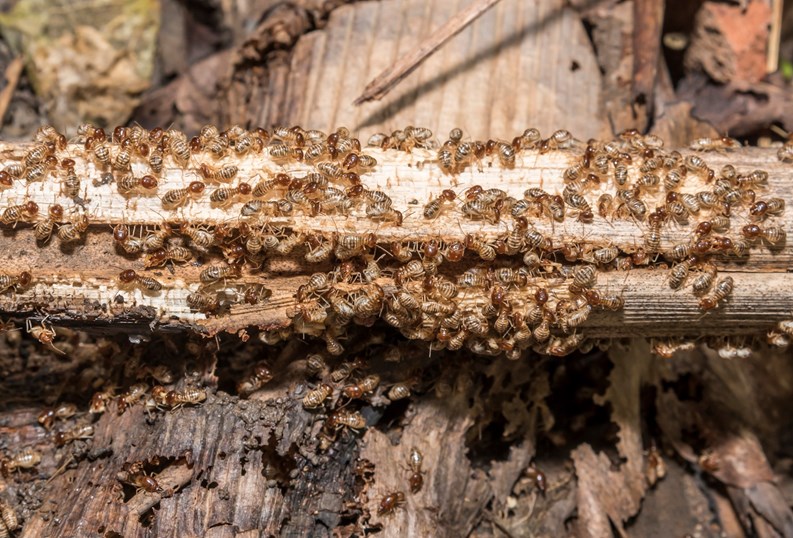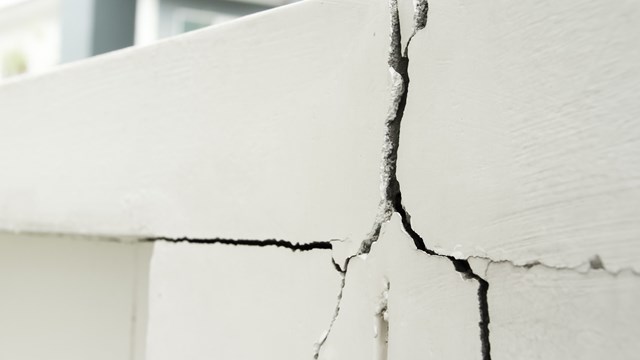Whether interior or exterior, well-built, properly-maintained woodwork can last for centuries but if wood-boring pests like beetles, termites, and carpenter ants find their way into the wood, they can wreak all kinds of havoc. Wood-destroying insects are more than a nuisance; they are dangerous and can cause significant, costly damage to the structure of a townhome, condo or co-op. They can also cost a small fortune to eradicate.
Wood You Rather
According to Scott Gosney, the owner of Advanced Pest Control in West Palm Beach, “There are several types of wood destroying pests, like subterranean termites—and there are several species of them in South Florida and throughout the Sunshine State. The most damaging and destructive is a species called the Formosan termite. There are also drywood termites, which are a completely different species, which live in the material they are eating, rather than in the ground. There are also powderpost beetles and powderpost termites, plus quite a few more—but they’re much rarer.”
Wood destroying insects often enter buildings searching for food, frequently hitching a ride inside wood products brought into the home.
And oftentimes, you don’t even see them until the damage is being done. “Wood destroying insects will damage wood while feeding on it, or creating tunnels and nesting areas in it,” says Louis Taranto, the owner of Tonto Pest Control in Brooklyn, New York. “They are generally very secluded, spending most of their time inside the wood they’re invading.” The telltale signs of a wood pest infestation include tiny pinholes visible on wooden surfaces, or even little piles of sawdust collecting under a wooden frame, art object, or piece of furniture—the debris left over from the critters’ chewing and tunneling.
Gosney adds, “Termites are active year round. They become evident at certain times of the year because they swarm. That’s when most people notice them, but they are always active. Some species swarm one a year, some twice.”
An Insect Primer
According to Michael Bentley, Ph.D, staff entomologist for the Virginia-based National Pest Management Association (NPMA), “Termites and wood-destroying beetles are the most economically important wood-destroying pests that infest homes (including co-ops and condos) in the U.S.” Of the two, it’s termites that are the most problematic and economically important—and the pests are found in every state in the union but Alaska.
“Wood destroying beetles are more widely distributed than termites, occurring in every state,” Bentley says. “However, they come second to termites in terms of economic importance. Termites are classified into three groups: subterranean, drywood and dampwood, based upon their nesting preferences. Subterranean termites are the most widespread and costly group. For termites, adults and immatures are responsible for feeding damage [to wooden structures], while the larvae of wood-destroying beetles cause the most damage to lumber.” Both insect groups can inflict damage to homes year round. But adults are usually most visible and active during the spring.
And according to Bentley, some species of subterranean termite and several important species of wood-destroying beetles aren’t even homegrown hassles—they were unintentionally introduced into the United States as invasive species, hitchhiking from other countries on solid wood packing materials, such as freight pallets or in ships’ dunnage.
“Non-native termites and wood-destroying beetles have originated from both tropical and temperate habitats,” he says. As their names suggest, “Many of the most costly non-native termite species, including the Formosan and the Asian subterranean termite, originated from various countries in Asia.”
And it appears the invaders have gotten friendly with each other. In 2015, a hybrid species of subterranean termite was discovered in South Florida that resulted from cross-breeding between the Asian and Formosan subterranean termite species. Separately, these termites cause billions in damages to structures worldwide.
“Researchers in South Florida confirmed that cross-breeding will readily occur between both species, and that the hybrid colony appears to grow faster than either parent species,” Bentley says. “This hybrid species could pose a serious threat to structures, however it is only known to occur in an isolated area of South Florida. So, it poses no threat to the rest of the U.S. at this time.”
According to the Florida Department of Agriculture and Consumer Services (FDACS), Formosan termites are seemingly more destructive than native species. They can cause tens of thousands of dollars in damage, and colonies reportedly contain millions of insects. A mature queen can lay up to 3,000 eggs a day, says the department. One particular subterranean species, the conehead termite, has only been found in Broward County, but its danger is just as formidable to homes and property.
Working with Buildings
For most of the U.S., pest issues tend to be seasonal, increasing in severity as temperatures rise and rainfall increases. These favorable weather patterns typically occur around early/mid-spring. However, the Southeastern states (Florida in particular) tend to sustain favorable conditions for pests nearly year round. To address these fluctuations, most buildings and HOAs work on a monthly service agreement with their pest control contractor, and when the exterminator arrives at the property, they are given a list of what shareholders or unit owners have problems.
Taranto says that it’s important that every resident in the building understands the importance of looking for signs of wood-damaging insects and not to let even a mild infestation go unchecked.
“If someone notices a problem, they need to act on it and not wait, because this could not only cause more damage to their home, but to the other residents and the building itself,” he says. “They should call whoever is in charge of that in the building so we get notified.”
There are things buildings can do to prevent termites and other pests from becoming a problem in the first place, according to Gosney.
“Proper maintenance of a building goes a long way,” says Gosney. “Most buildings, especially here and along the coast, are made of concrete materials. The only place that these wood-destroying organisms are going to find their way into is wood. So a good paint job and a building that’s nicely maintained is the best preventative there is for termites.”
Gosney does note that when it comes to subterranean threats to make sure your building has been properly treated. He explains that there are two kids of subterranean treatments: liquid termiticide applied around the building’s foundation, and bait stations and monitors.
According to the FDACS, , Florida statute Chapters 482 and 487 and the state’s building code address termite issues for pest control specialists, including what types of termiticides and preventative treatments are allowed and what type of notification is required.
Gosney stressed that whoever you hire should be licensed by the state of Florida. “There are four different licenses in the state: there’s GHP, general household pests, most operators have that and it allows them to handle things like roaches and general pests; then there’s a lawn and ornamental, which is more about lawn insects and plants; then there’s two different termite licenses, there’s the subterranean, which is just your general termite, then there’s a fumigation license, which is more specific for the dry-wood type of termites,” Gosney explains. “You want to be dealing with a company that’s licensed in all four of those areas.”
Top Tips
Bentley encourages boards, managers and residents alike to take a few simple steps to eliminate conditions that are make a property attractive to wood-destroying insects. He says the best way to prevent problems with wood-destroying insects is to make sure that any water-damaged wood in your building or unit is replaced promptly, and that any wood used in your home or in structures around your property is stained or painted, since raw, untreated wood is far more vulnerable to pest infiltration than its varnished, painted, or stained counterpart.
Here are the NPMA’s top tips to help prevent a termite infestation:
Keep basements, attics and crawl spaces well-ventilated and dry.
Repair leaking faucets, water pipes and A/C units on the outside of the home or building.
Repair fascia and soffits and rotted roof shingles promptly and properly.
Replace weather stripping and repair loose mortar around basement foundations and windows.
Direct water away from your home or building through properly functioning downspouts, gutters and splash blocks.
“Termites are highly attracted to moisture, so any possible moisture sources such as leaky pipes, improperly sealed windows and doors, and poor exterior drainage should be corrected immediately,” Bentley says. “Additionally, preventing any structural lumber from making contact with soil is another effective way to prevent termites from feasting on your home.”
It is more difficult to prevent wood-destroying beetles from infesting structural lumber. However, an effective strategy for deterring both termites and wood-destroying beetles is keeping firewood or other cellulose (yard waste, branches, tree stumps) off of the ground and stored away from the building.
Safe Products
Unlike decades ago, the modern options available to pest professionals for managing wood-damaging insects troubling your co-op or condo are registered with the Environmental Protection Agency (EPA), meaning they have been tested and are considered safe for people, pets, and the environment.
For example, according to Taranto, new termite control options that have come about in the last 15-20 years include termite baiting, a treatment that exploits the constant foraging behavior of termites to transport the active ingredient back to the nest where they share the poisoned bait with their fellow nest-mates, thus eradicating the colony. Another option is a wood-applied borate treatment that is most commonly applied to raw lumber before it’s even incorporated into a construction project.
There’s another option that’s been brought out from California: killing termites with heat.
According to Gosney, “Depending on the circumstances, and we’ve done quite a number of these in condos, we can get rid of drywood termites inside of cabinetries and walls using heat. There’s no fumigation involved, it’s just heat that penetrates the wood and kills the termites. The wood itself has to reach only 120 degrees, but it has to reach that temperature all the way through the wood. So we have to generate temperatures of 140 degrees and up to get it to that temperature.”
“We use heaters of all sorts to do this,” he continues. “We have, probably, half a million dollars’ worth of equipment that we can use to heat anything from an entire building to a kitchen.”
And, Gosney adds, “Because heat is a very specific type of treatment, this has to be done very thoroughly and we don’t always have control over all environments. There are certain things, heat sinks like concrete, that will just suck in the heat and we can’t use it as a result.”
“You can’t just heat up the whole building and think everything is going to die; it’s a much more complex process than that,” Gosney says. “Sometimes the only choice, for drywood termites, is fumigants.”
Regardless of whether they’re just a nuisance (like kitchen ants) or a potentially-costly threat (like termites), nobody wants any kind of bugs in their building. And while a certain amount of pest-related trouble is inevitable in any environment, by staying vigilant for the signs of trouble and removing as many risk-factors as possible from your property, you may be able to avoid having your woodwork chewed into sawdust by these strong-jawed invaders.
Keith Loria is a freelance writer and a frequent contributor to The South Florida Cooperator.







Leave a Comment